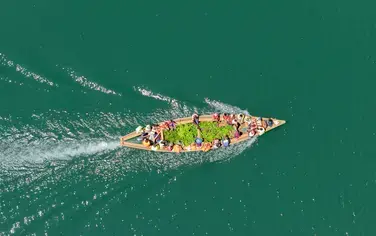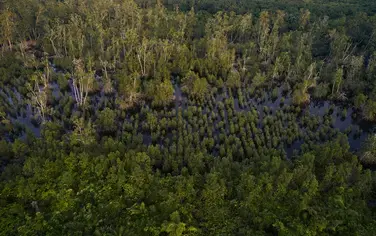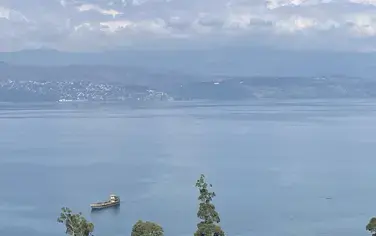Africa is currently losing around 3 million hectares of forest per year, threatening livelihoods of people as well as the habitat of vulnerable wildlife such as elephants. The Congo Basin and Eastern Africa regions have some of the highest deforestation rates in the world. If business as usual continues, the two regions combined are projected to lose around 24 million hectares of forest by 2030.
Concurrently, nearly 65% of the land in Africa is affected by forest degradation — changes within forests that negatively affect its structure and functions over many decades, and thereby lower the capacity to supply products and/or ecosystem services. Forest degradation threatens agricultural productivity, which is vital to livelihoods and national economies of most countries.
Forest Landscape Restoration (FLR) is an important approach to respond to the threats posed by deforestation and degradation in Africa, and to enhance livelihoods, maintain habitats and boost agricultural productivity. FLR is a long-term process that restores ecological functionality of degraded or deforested land to enhance human well-being for present and future needs. FLR is more than just planting trees — it involves multiple stakeholders, helps to clarify and protect communal land tenure rights, addresses poverty, and ensures complementarity of land-uses across landscapes, among others.
This is why Tanzania’s announcement this week that it will restore 5.2 million hectares of degraded and deforested land (6% of total land in the country) is a welcome step. The commitment is part of the African Forest Landscape Restoration Initiative (AFR100) under the Bonn Challenge — a global effort to restore 100 million hectares of degraded and deforested land in Africa, and 350 million hectares globally, by 2030. This new commitment from Tanzania adds to the millions of hectares already committed by other African countries to date.
For Tanzania, this announcement comes at a much-needed moment. Both deforestation and degradation are on the rise — recent statistics from Tanzania’s National Carbon Monitoring Centre, submitted to the United Nations Framework Convention on Climate Change (UNFCCC), indicate that the country is losing an estimated 469,000 hectares of forest area each year — an alarming 25% increase from 2015. According to the Tanzanian Vice President’s Office, 62% of Tanzania’s 89 million hectares of land is degraded. That is equivalent to around 55 million hectares of land that is affected across the country.
There is urgent need for a nationwide movement to create the necessary political will, support local capacity, develop partnerships, and mobilize critical finance to address the growing challenges of deforestation and degradation.
The AFR100 is the mechanism by which the Bonn Challenge is implemented in Africa. It is made up of financial and technical partners that provide support to governments to assess, design and implement FLR at scale. These types of partnerships are crucial for FLR to succeed, because restoration requires multiple strategies, experiences, capacities and stakeholders. This is why, in 2017, WWF joined AFR100 as a technical partner, given our vast experience over two decades on restoration, our global presence, and the Trillion Trees partnership with BirdLife International and the Wildlife Conservation Society.
Tanzania is the first country WWF has supported to join the global race for restoration. In this process, we have worked closely with the Tanzania Forest Service (TFS) to officially join the AFR100, to leverage partnerships with other government agencies, civil society organisations and NGOs, to leverage technical support through engagement with other key stakeholders including IUCN, WRI and WCS, and to begin developing the National FLR Programme in order to realize the 5.2 million hectares target.
In Tanzania, WWF has a long history in forest restoration, having implemented a long-term restoration programme (2004–2013) in the East Usambara Mountains with the Tanzania Forest Conservation Group, increasing vegetation cover by 963.25 hectares and securing land and forest tenure of 18 villages. We are currently working with Mpingo Conservation Development Initiative, Mchakama village and the Kilwa district council to restore Erythrina schliebenii, a local fern, believed to have gone extinct in 2008. This partnership has so far managed to triple the size of the Mchakama community forest reserve from 1,526 to 5,639 hectares in just two years, restoring the medicinal values of the E. schliebenii to the people of Mchakama village and Kilwa district. Through the Trillion Trees programme, WWF and TFS have supported restoration efforts in Pugu (2,400 hectares) and Kazimzumbwi (5,005 hectares) Forest Reserves in Dar-es-Salaam where a total of 49,000 seedlings have been planted since 2017. The two forest reserves offers ecotourism opportunities for Dar-es-Salaam residents through bird watching, school trips, camping and hiking thus providing employment to surrounding communities.
Going forward, we will use the experience we have acquired over the last two decades on restoration and leverage our innovative approaches (e.g. New Generation Plantation platform and the Landscape Finance Lab) to continue to support the Tanzanian Government’s ambition to develop and implement FLR. Drawing on our experience in Tanzania, we will also aim to scale up our work in other countries where we are supporting FLR — Kenya, Zambia, Madagascar, Uganda, Mozambique, and the Congo Basin.
As AFR100 partners meet at the end of this month in Nairobi, we at WWF are looking forward to enhancing our ongoing partnerships and forging new ones, to make the FLR commitments a reality in Africa. We are committed to this process and will continue to strive for excellence across many countries in Africa where we have a presence.
Read the original version of this article here. It has been updated to include the latest commitments to AFR100.




